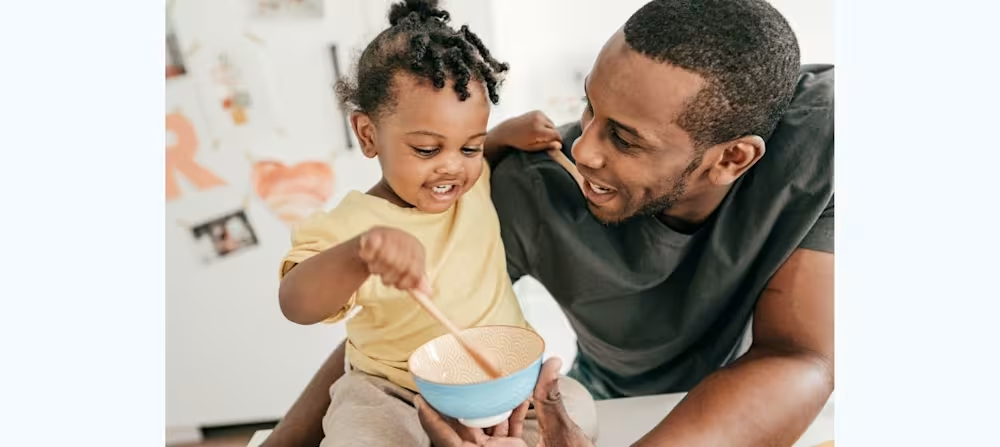20 month old toddler milestones: Development, growth, speech, language
Updated Dec 02, 2025

Toddlers are full of surprises at 20 months, rapidly refining existing skills, learning new ones, and discovering additional ways to let those little personalities shine. At this age, your toddler may explore a range of milestones, from speech and language development to emotional and fine motor development. As their second birthday approaches, 20 month olds are often working on exploring empathy, expanding their communication, problem-solving, and making moves toward running.
In this article, we'll take you through the milestones you can expect from 20 - 21 months, give you a handy 20 month old development checklist, and provide useful tips to support your little one's growth.
Editor's note
When we discuss children and development at Huckleberry, we use their adjusted age (vs. actual age). Not all kids will reach 20 month old milestones at the same time — and that’s normal. There’s a wide spectrum when it comes to how fast toddlers grow and develop. While many kids do reach these milestones between 20 - 21 months, this isn’t always the case. If you have any concerns or questions about your child’s development, reach out to their pediatrician.
Table of Contents
20 month old toddler milestones at a glance
One year and eight months is an exciting age that usually includes milestones across development, sleep, and feeding.
Development:
You may find yourself navigating tantrums as your toddler continues learning to communicate what they want — and coping with frustration when they can’t have it. They may also be eager to do things on their own that they’ve learned from watching you, like dressing themselves [] (with help) or “feeding” a stuffed animal. Toddlers this age may also be starting to use their imagination while playing and putting 2 - 4 words together [] to form their first sentences, like “more milk.”
Sleep:
As your toddler gets closer to 2 years old, you’ll find their wake windows lengthening, and with that, bedtimes often get later. However, continue to aim for about per day with 1 nap. For most 20 month olds, this typically looks like 11 - 12 hours of sleep at night, 2 - 3 hours of day sleep, and 5 - 5.75 hours of awake time in between sleep periods.
Some toddlers may also experience a sudden period of disturbed sleep around this age, commonly referred to as the.” However, despite popular belief, sleep regressions don’t happen at predetermined ages. Instead, multiple factors may impact sleep around this time.
Remember, every child is different and so are their sleep needs. There’s a wide range of normal when it comes to toddler sleep and the recommended hours are just a rough estimate — try not to stress about hitting exact numbers. Instead, keep in mind that your little one’s mood and energy levels are also important indicators of whether they’re getting enough rest.
Feeding:
Most 20 month olds eat food roughly five times a day, typically three meals and two snacks. At this age, your little one may be more opinionated (and vocal!) about their likes and dislikes. Although 20 month olds can eat an increasing variety of food [], picky eating is also common, so don’t be alarmed if they don’t eat much or suddenly refuse previous favorites. Continue offering well-balanced options and try to avoid putting pressure on your child to eat [].
20 month old developmental milestones
Physical development
Gross motor milestones
By 20 months old, your little one has likely mastered walking and is using that confidence to branch out and try new skills. Between 19 - 24 months, you can expect your toddler to start jumping with both feet leaving the ground, being able to pull toys behind them as they walk, and trying to stand on their tiptoes []. At this age, some toddlers may also be able to carry large or several toys while walking and climb on or off furniture unassisted []. During this period, you may even see your little one learning to run, kick a large ball, and walk up or down stairs (with support).
Keep in mind that there’s a wide range of normal when it comes to milestones, so don’t worry if your little one isn’t quite crushing all of these new skills just yet. However, check in with your child’s healthcare provider if they’re not taking independent steps yet.
Fine motor milestones
This age is an exciting time to see their creativity and curiosity bloom through fine motor skill development []. At 20 months, your toddler may be able to start using crayons or markers to make marks (aka works of art!) on paper, making stacks of five or more small blocks, and sorting shapes or colors. Your inquisitive little one may also be flipping switches on and off or taking toys apart and putting them back together. As their second birthday approaches, they may also start turning over containers to pour out the contents and you may notice a hand preference develop [].
Speech development
Around this time, toddlers’ vocabularies are expanding rapidly (some may say 50 - 100 words by their second birthday) [].
Language skills: Your 20 month old is likely building a 50+ word vocabulary and may also be starting to use 2 - 4 word sentences and simple phrases []. By 21 months, toddlers are typically able to understand simple pronouns and know 3 - 5 body parts. Between now and 24 months, your little one may also be able to recognize objects or pictures and point to them when you name them. They may also be able to follow simple instructions, recognize the names of people, and start repeating words they overhear (for better or worse!). This is also an exciting time for language comprehension. Between 18 - 24 months, toddlers typically go through a period of “language explosion” [] where they're rapidly learning new words and can understand much more than they can say — for now.
Mimicking: As your little one develops a 50+ word vocabulary [] around this age, you may want to watch what you say around them. That’s because toddlers turn into little parrots, repeating words they overhear in conversation [] (even the bad ones!). By 21 months, you can also expect your little one to consistently imitate new words [] and possibly even behaviors [] they see others doing.
Social development at 20 months
Using their imagination: Many 20 month olds are beginning to use their imagination and have fun with it. Instead of just manipulating household objects or toys, toddlers this age often use them in pretend play (and may mimic you in the process!). It may look like your little one pretending to feed their favorite stuffed animal or brush their doll’s hair []. As kiddos near their second birthday, you can expect to see them using gestures in pretend play along with words they’re learning [].
Mood swings: At 20 months, it may feel like you have a teenager on your hands with unpredictable mood swings []. As little ones learn new skills that allow for greater independence, many are also gaining a greater understanding that they’re a separate individual (which may feel scary at times). This often results in abrupt attitude changes, flopping between fiercely independent kiddo who wants to do everything themselves and a suddenly clingy little one in the throes of .
Follow your lead: Although many 20 month olds are eagerly asserting some independence, you may see them turning towards you to check in and lead their emotions, especially in new situations []. If your little one is unsure how to react or feel about something, they may stop to look at your face first to see how you feel then follow suit..
20 month milestone checklist
Below is a general checklist of milestones toddlers may reach by 20 months. Keep in mind all children are unique, and there's a spectrum of normal milestones at 20 months. However, if you are concerned about your child’s growth or potential developmental delays, contact their healthcare provider.
Milestones to watch for at 20 months:
Uses simple phrases (18 - 24 months) []
Starts to jump with both feet leaving the ground
Runs
Stands on tiptoes
Climbs on low furniture
Kicks large ball
Goes up and down stairs (with support)
Flips switches on and off
Scribbles
Sorts shapes and colors
Stacks 4+ or more small blocks or toys
Takes toys apart and puts them back together
Uses at least 50 words (19 - 21 months)
Consistently imitates new words (19 - 21 months)
Understands simple pronouns (me, you, my) (19 - 21 months)
Identifies 3 - 5 body parts when named (19 - 21 months) []
Locates objects you’re pointing to
Eats with a spoon (19 - 24 months)
Holds something in one hand while using the other hand (19 - 24 months)
Tries to flip switches, turn knobs, and press buttons (19 - 24 months)
Plays with more than one toy at the same time (19 - 24 months)
What are 20 month old development red flags?
There's a range of normal when it comes to toddler milestones — if your child hasn't hit all of the above milestones at this age, that's OK. However, there are some signs that may need attention from their healthcare provider. Talk to your family's doctor if your child []:
Isn't pointing
Isn't walking
Doesn't share things with others
Doesn’t comprehend how to use common items like a brush or cup
Doesn’t copy others
Doesn’t speak at least six words or isn't learning new words
Doesn’t react when a caregiver leaves or comes back
Loses skills they previously had
If you have any other concerns or questions about your toddler's development, contact their healthcare provider. It's usually preferable to err on the side of caution when it comes to your little one.
3 development tips for 20 months
Tip | Why it helps | What to try |
|---|---|---|
Think of snacks and meals in the same way | Toddlers often eat unevenly at this age. Treating snacks as miniature meals reduces pressure, supports autonomy, and helps you zoom out on nutrition over the whole week. | Provide nutritious options at each eating opportunity and let your toddler decide what — and how much — to eat. Keep mealtimes low-stress. |
Make goodbyes predictable and calm | Separation anxiety is common at 20 months. Consistent departures help toddlers understand that you come back and reduce the fear of sudden disappearances. | Offer a short, warm goodbye and a clear reassurance before leaving. Skip sneaking out, which can increase clinginess and make separations harder next time. |
Stay steady with boundaries | Emotional intensity spikes at this age. Clear limits paired with calm responses help toddlers build self-control and understand what behaviors are safe and acceptable. | Give simple, firm guidance (“Blocks stay on the floor”), redirect to a safe option, and praise cooperation right away. Aim for calm consistency, not perfection. |
Find more details below:
Tip #1: Think of snacks and meals similarly
Sometime after your little one’s first birthday, they may have started eating less or being fussier about what they will eat. Although frustrating, a decrease in appetite and picky eating are normal at this age. While we traditionally think of meals as larger eating occasions and snacks as , try thinking of all meals equally. Instead of feeling pressure to get them to eat three “large” meals, treat snacks as mini-meals with nutritious options. If you’re offering well-balanced food options throughout the day, it can take the worry out of the amount of food eaten during each meal. This can help keep stress off of kiddos when it’s time to eat and help food feel fun.
Tip #2: Be intentional with goodbyes
Many toddlers this age are increasingly aware that they are separate individuals from others, especially you, and they aren’t always thrilled about it []. Although kiddos this age typically love asserting their independence, many still suffer some separation anxiety when you’re leaving even if it’s only for a few minutes (and that’s completely normal).
To help your child’s anxiety, calmly say goodbye before leaving and reassure them that you’ll return. And if they’re fussing, keep that calm demeanor on the outside, even if you feel just as upset on the inside as they do. And if you try to sneak away without them noticing, it might backfire and cause them to be more clingy because they worry you’ll leave again unexpectedly.
Tip #3: Stay calm — and clear with limits
At this age, toddlers typically have limited self-control and language skills to communicate what they want. They also don’t have the physical ability to do what they want or the skills to deal with this frustration. This combination often results in those infamous “Terrible Twos” meltdowns.
To help your 20-month-old learn self-regulation, set clear, consistent limits instead of using punishment — this builds security, teaches appropriate behavior, and encourages cooperation. For example, if your toddler is banging a block against a window or door, try []:
Setting the boundary with words and actions. It’s often more effective for toddlers to hear the words together with the actions when you’re setting limits. So instead of just saying “no” or “stop,” try combining words with actions or gestures (like shaking your head no as well).
Redirecting: Verbalize that you understand what it is that your toddler is trying to do (e.g. play with the block at the window) and then redirect their behavior. For example, after acknowledging their desire to bang the block, explain that it’s not OK to bang on glass because someone could get hurt and offer an alternative like playing elsewhere instead.
Give positive feedback: Once your little one tries the alternative behavior, give them positive feedback instead of focusing on what it was that they shouldn’t have done. This extra praise helps reinforce the “right” behavior you’d like to see continue.
Although it can be hard, try to stay patient and remember that your little one isn’t intentionally trying to ignore or defy you. Toddlers this age aren’t able to understand the consequences of their actions or remember the rules without you telling them. They’re still working on the self-control to stop themselves from repeating unwanted behavior too. Being calm and consistent with limits helps your child to learn how to manage their strong emotions eventually and teaches them what is and is not acceptable.
Activities for a toddler at 20 months
1. Play with water
Water play is great for fine motor coordination, cause-and-effect learning, and developing sensory skills. Plus, you probably already have everything you need already. Give your toddler plastic cups, spoons, and small containers in the bath (or even use a shallow tub with a little water outside) and let them experiment. Scooping, pouring, and transferring water between cups may not seem very exciting to you but your little one will likely
2. Recap their experiences
Your little one is constantly learning from everything you do and say. Research has found that parents talking to their toddlers about their experiences helps them remember those moments better []. Consider incorporating time to chat about your little one’s day into their bedtime routine. Not only is this nightly recap another opportunity to connect before it’s time for sleep, with toddlers about their life experiences also helps them understand the world around them better.
Caring for a sick toddler at 20 months
When toddlers are sick, their sleep, energy, and appetite can all be affected. These tips can help your little one feel more comfortable and supported while they recover — and hopefully they’ll be back to their usual self in no time.
Keep them hydrated: Fluids are key your toddler isn’t feeling well. It's normal if meals are less appealing while they're under the weather, so offer frequent small sips of water or milk to help keep them hydrated.
Ease congestion: A stuffy nose can make eating and sleeping tricky. A cool-mist humidifier, saline drops, and gentle suction can help clear congestion before they head to bed.
Monitor fevers: Call your pediatrician if your toddler’s fever lasts more than 24 hours or climbs above 104°F (40°C) repeatedly []. If your doctor gives the go-ahead, infant or children’s Tylenol or Motrin can be used. Avoid cough and cold medicines, which are not safe for young children.
Be flexible with sleep: Illness often disrupts sleep routines. Your 20-month-old may nap more or less than usual, or wake frequently at night. Follow their cues and return to the regular schedule once they’re feeling better.
Offer extra comfort: Some toddlers want extra cuddles, while others prefer space, especially when they're sick. Follow their lead to help them feel safe and supported. And don’t forget to lean on your support system when you need a break — caring for a sick child is no small task.
When to seek help
If your child has a fever for more than 24 hours or it reaches above 104°F (40°C), call their doctor right away. These can be signs of a more serious infection or illness and it's best to rule out anything that needs medical attention.
In general, if something feels off or you’re worried about how your child looks or acts, it’s safest to check in with their doctor. And if you already talked to them but symptoms appear worse, that’s a good time to check back in too.
Takeaway
Toddlers at 20 months olds may be going through a “language explosion” and rapidly comprehending new words — even if they can’t speak them yet.
20 month olds may learn to run, stand on tiptoes, climb on low furniture, and jump with both feet leaving the ground.
Toddlers this age are typically eating three meals and two snacks per day. However, picky eating and inconsistent appetites are common at this age so don’t be alarmed if your little one doesn’t eat everything.
There’s a wide range of what’s considered “normal” when it comes to 20 month milestones and some toddlers master skills at different speeds. However, always listen to your gut and contact your child’s healthcare provider if you notice any concerns, developmental red flags, or delays.
To encourage growth and development at 20 months old, you can try thinking of snacks and meals the same, being intentional with goodbyes, staying calm while setting clear limits, and recapping their experiences with them.
20 month developmental milestones FAQ
Share article:
Note: The content on this site is for informational purposes only and should not replace medical advice from your doctor, pediatrician, or medical professional. If you have questions or concerns, you should contact a medical professional.
11 Sources
Table of Contents
Share article:






